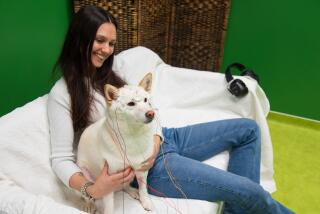Animals have feelings too
Temple GRANDIN’S fame came for the wrong reason. She’s known as an autistic woman with a doctorate in animal science because neurologist Oliver Sacks devoted an essay to her in his book “An Anthropologist on Mars.” But Sacks’ book came after Grandin quietly made life better for farm animals. All over the world, her livestock management systems made animal husbandry more profitable and humane.
“Animals in Translation” is basically a book about the mammalian brain, ours and those of other (mostly furry) creatures. Animal behaviorists are learning that what we believe makes us unique -- language, emotions, the ability to reason -- exists throughout the animal world. The main way we differ from animals is that our minds filter what we see.
To understand filtering, imagine watching a basketball game. Your job is to count the passes, and at one point, a woman in a gorilla suit wanders by. You think you’d notice, right? Well, in a noted experiment, subjects were asked to count passes in a video of a basketball game. Half didn’t notice when the woman in the gorilla suit wandered onto the court. That’s filtering -- what neurologists call “inattentional blindness.” Meaning humans tend not to see what we’re not looking for.
Animals don’t have inattentional blindness. They don’t filter information. Autistic people filter far less than the rest of us. And people with attention deficit hyperactivity disorder and dyslexia filter somewhat less than the rest of us. Grandin believes that she sees the world more as an animal sees it, visually -- without much of a subconscious. Without denial or repression.
But animals do have emotions and desires. Love, curiosity, attachment to offspring and friendship are survival tactics that evolution bred in. An animal that is not curious is less likely to find food. Love and friendship allow animals to work together. Reading Grandin, one wonders whether Freud should have looked more to the animal kingdom when formulating his theories. Grandin makes her philosophical challenges through simple descriptions of scientific data -- she has more than 300 articles to her name -- but without scientific murkiness. Her literal prose, almost completely without metaphor, allows ideas to sink in until they feel like your own.
Unfortunately, what will sell the book are the National Enquirer-style animal stories: rapist roosters; sex-crazed stallions; superstitious pigs. Or, more interesting, that prairie dogs use language to describe the individual personalities of hawks and wolves. Communicating with language is simply what some animals do to keep from being eaten.
The real reason to read this book is its deeply logical approach to compassion. “Animals in Translation” tells what it’s like to have a mind that is not normal for humans. Grandin believes she sits between animals and humans. Like a cow or a dog, she sees exactly what is there. We have to know how a consciousness -- human or animal -- experiences the world if we are to reduce suffering.
The most uplifting section describes how dogs helped us evolve into modern humans. Skull studies show that not only did canine brain size decrease as wolves became dogs, but our brains reduced in size in the areas governing smell and sense during the same period. Dogs took over the prey and predator detection, allowing evolution to favor human intelligence over human sense of smell. Wolves may also have taught us friendship; humans are the only primates who have friends, while wolf packs depend on it. We owe our dogs ourselves.
There are disturbing moments: Studies of other animals with large frontal lobes indicate that violence in young males is an evolutionary trade-off. Intelligent brains take a long time to mature. Some brains, especially those of males, can short-circuit along the way. Chimpanzees wage war. Dolphin gangs rape and kill.
“Animals in Translation” may end up being the best animal book of the year, certainly the most human. It’s cold science proving a near-religious argument for compassion. Some brains filter less and so become overwhelmed -- the autistic person curled up in a corner, the ADHD child running wild. The dyslexic who sees and is hurt by the flicker of fluorescent lights, or cows hurting when they go quickly from light to darkness. Grandin’s argument is simply that living beings should not be exposed unnecessarily to pain. *





